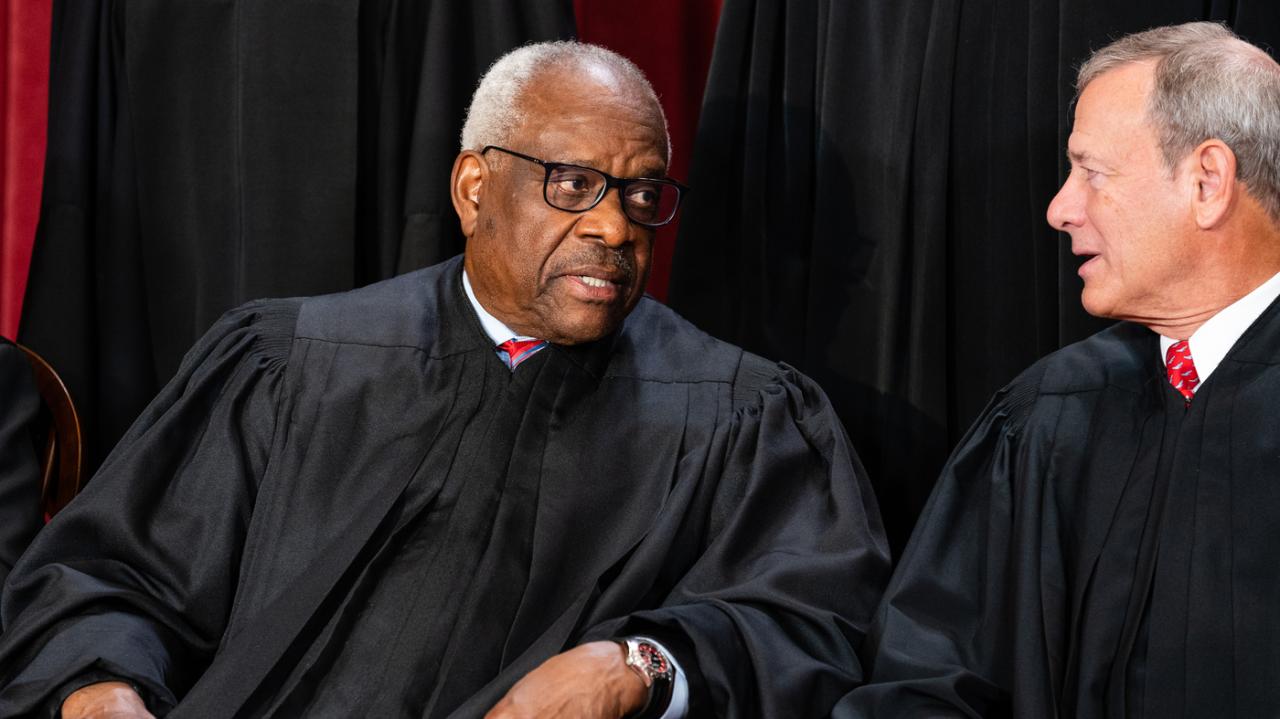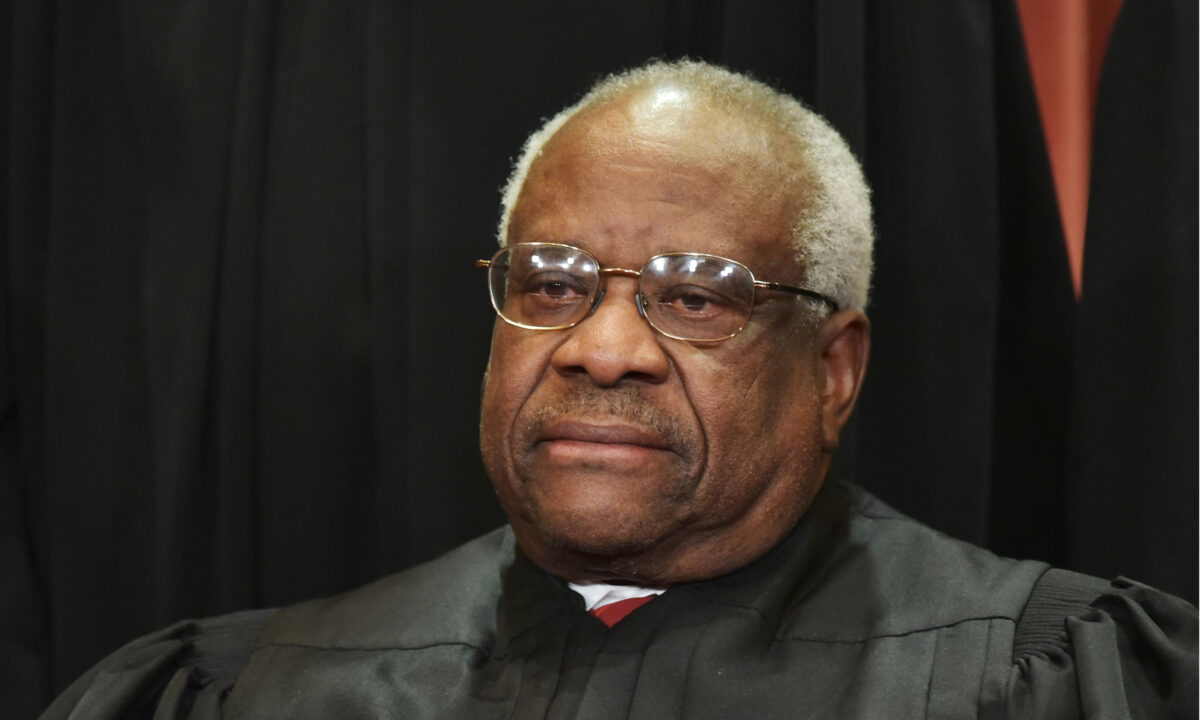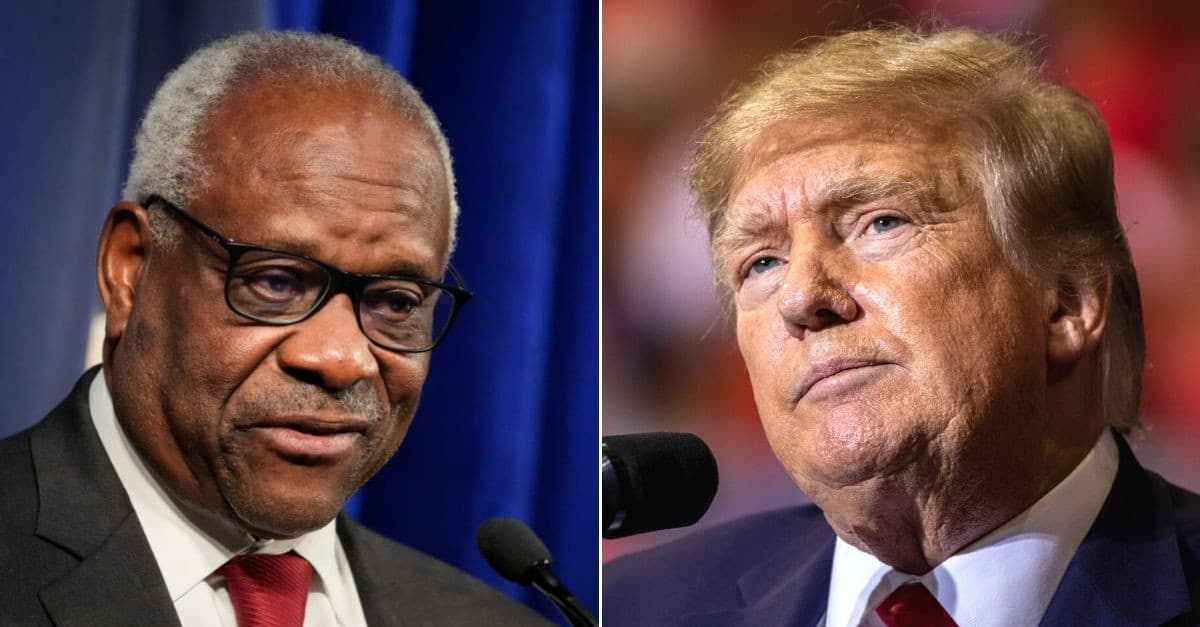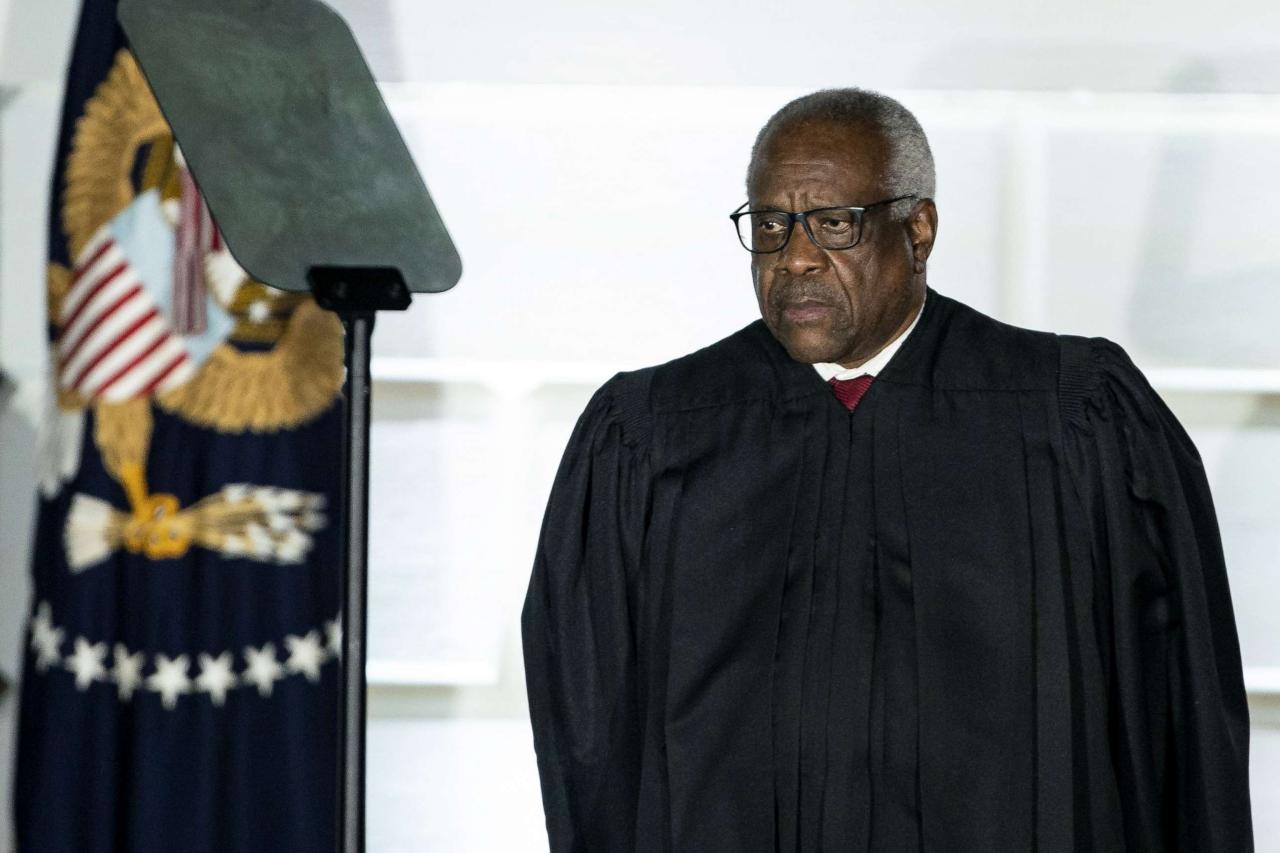Federal courts won’t refer Clarence Thomas for DOJ investigation – Federal Courts Reject Thomas DOJ Referral: The recent decision not to refer Supreme Court Justice Clarence Thomas for a Department of Justice investigation has sparked intense debate. This refusal, based on the judiciary’s established processes for handling ethical complaints against justices, raises crucial questions about accountability and transparency within the highest court of the land. We’ll explore the legal arguments, public reactions, and potential long-term implications of this significant development.
This complex situation involves navigating the delicate balance between judicial independence and the public’s need for accountability. Understanding the historical context, the limitations of the DOJ’s authority, and the various perspectives surrounding this case is essential to grasping its significance. We’ll examine the ethical concerns raised regarding Justice Thomas’s financial dealings and the arguments both for and against a formal investigation.
The Judicial Branch’s Handling of Ethical Complaints Against Supreme Court Justices
The process for addressing ethical complaints against Supreme Court justices is complex and largely self-regulating, lacking a formal, independent investigative body. This has led to considerable debate about accountability and transparency.
Ethical Complaint Procedures
Historically, ethical complaints against Supreme Court justices have been handled internally within the Judicial Branch. The Chief Justice often plays a significant role in addressing concerns. There’s no established, codified process, leading to inconsistencies in how complaints are investigated and resolved. Often, the process involves informal inquiries and internal review, with little public transparency.
Historical Precedents
While there isn’t a long history of formal investigations, several instances highlight the lack of a clear, consistent process. Past instances have often involved internal discussions and reviews, with outcomes ranging from no action to private reprimands. The lack of public disclosure makes it difficult to fully assess these precedents and draw definitive conclusions about their effectiveness.
Comparison with Past Cases
The current situation regarding Justice Thomas differs from past instances primarily in the level of public scrutiny and media attention. Previous cases often received less public attention, allowing for more discreet internal handling. The increased public interest in this case has intensified calls for greater transparency and accountability.
The Department of Justice’s Investigative Powers
The Department of Justice’s authority to investigate ethical violations by Supreme Court justices is limited and subject to legal and practical constraints. While the DOJ can investigate other high-ranking officials, the independence of the judiciary poses significant challenges.
Limitations of DOJ Authority
The DOJ’s power is constrained by the principle of separation of powers. Investigating a Supreme Court justice could be perceived as an encroachment on the judicial branch’s independence. Furthermore, any investigation would likely face legal challenges related to jurisdiction and potential violations of executive overreach.
Procedural Hurdles
Potential legal hurdles include challenges based on executive overreach, the need for a clear demonstration of a federal crime, and potential claims of violating the separation of powers doctrine. The high bar for initiating a DOJ investigation against a Supreme Court justice adds complexity to the process.
DOJ Investigations of High-Ranking Officials, Federal courts won’t refer Clarence Thomas for DOJ investigation
The DOJ has investigated high-ranking government officials for ethical misconduct in various contexts. These investigations often involve allegations of bribery, corruption, or abuse of power. However, the cases involving Supreme Court justices remain rare and often handled differently due to the unique position of the justices within the government structure.
Public Opinion and the Thomas Case
Public reaction to the decision not to refer Justice Thomas for investigation has been sharply divided. The lack of a formal investigation has fueled criticism from various groups and individuals.
So, the Federal courts are declining to refer Clarence Thomas for a DOJ investigation – a pretty big deal. Meanwhile, in completely unrelated news, check out this article about the Canucks goalie situation: Canucks recall Arturs Silovs, Thatcher Demko remains out vs. It’s a stark contrast to the weighty legal matters surrounding Justice Thomas, isn’t it?
The lack of referral for Thomas leaves many questions unanswered, highlighting the complexities of the judicial process.
Diverse Public Perspectives
Public discourse reflects a wide range of opinions, with some arguing that the lack of investigation undermines public trust in the Supreme Court, while others maintain that the decision respects the independence of the judiciary. Concerns about potential conflicts of interest are central to much of the criticism.
Arguments For and Against Investigation
Arguments in favor of a DOJ investigation often cite concerns about transparency, accountability, and the appearance of impropriety. Conversely, arguments against an investigation emphasize the importance of judicial independence and the potential for political interference.
Media Framing of the Story
Different media outlets have framed the story through varying lenses, reflecting partisan divides. Some outlets have highlighted the potential conflicts of interest, emphasizing the need for accountability. Others have emphasized the need to protect judicial independence from political interference.
Ethical Guidelines and Conflicts of Interest
Supreme Court justices are expected to adhere to high ethical standards, though these are not explicitly codified in the same way as for other government officials. The lack of a clear, enforceable code has contributed to the ongoing debate.
Ethical Guidelines for Supreme Court Justices

While there isn’t a formal code of ethics, justices are expected to uphold the highest standards of impartiality and avoid conflicts of interest. These expectations are largely based on tradition, precedent, and the inherent responsibilities of their position.
Concerns Regarding Justice Thomas’s Finances

Concerns about Justice Thomas’s financial dealings center on the potential for undue influence and conflicts of interest. These concerns stem from the undisclosed gifts and financial support he and his wife have received.
Potential Conflicts of Interest
Potential conflicts of interest arise from the possibility that Justice Thomas’s financial relationships could influence his decisions on cases before the Supreme Court. The lack of transparency makes it difficult to definitively assess the extent of these potential conflicts.
Ethical Standards Compared
Compared to other branches of government, the ethical standards for Supreme Court justices are less clearly defined and enforced. This lack of explicit rules and independent oversight has been a source of ongoing criticism.
Impact on Public Trust and Supreme Court Legitimacy: Federal Courts Won’t Refer Clarence Thomas For DOJ Investigation
The decision not to refer Justice Thomas for investigation has the potential to significantly impact public trust in the Supreme Court and its perceived legitimacy. This lack of accountability could erode public confidence in the fairness and impartiality of the Court.
Erosion of Public Trust
Past events, such as the handling of controversial cases and accusations of partisan bias, have already damaged public trust in the Supreme Court. The current situation could exacerbate these concerns and further erode public confidence.
Impact on Legitimacy
The perception of the Supreme Court’s legitimacy is crucial for its ability to effectively function. A decline in public trust could weaken the Court’s authority and its ability to resolve disputes impartially.
Potential Long-Term Consequences
In a scenario where public trust continues to decline, the Supreme Court could face increased challenges in maintaining its authority and influence. This could lead to decreased compliance with its rulings and heightened political polarization surrounding its decisions.
So, the federal courts aren’t referring Clarence Thomas to the DOJ for investigation, which is a pretty big deal. It’s a stark contrast to other news, like the passing of Britt Allcroft, Britt Allcroft, Who Brought Thomas the Tank Engine to TV, Dies at 85 , a woman who brought joy to millions. The Thomas the Tank Engine news is definitely a lighter counterpoint to the ongoing legal drama surrounding Justice Thomas.
It just goes to show how diverse the news cycle can be.
Alternative Avenues for Accountability
Several alternative avenues exist for holding Supreme Court justices accountable for ethical breaches, although none offer a completely satisfactory solution given the unique position of the justices within the government structure.
Alternative Accountability Mechanisms

These include increased transparency and self-regulation within the judicial branch, strengthening existing ethics guidelines, and exploring the creation of an independent ethics body to investigate complaints. Each option presents its own challenges and limitations.
Effectiveness of Accountability Mechanisms

The effectiveness of each mechanism varies depending on its implementation and the willingness of the justices to cooperate. The lack of a formal, independent process remains a significant obstacle to ensuring accountability.
Comparison of Accountability Avenues
The following table compares the advantages and disadvantages of different accountability mechanisms:
| Accountability Mechanism | Advantages | Disadvantages | Feasibility |
|---|---|---|---|
| Increased Transparency | Improves public trust, discourages misconduct | May not address underlying issues, potential for backlash | High |
| Strengthened Ethics Guidelines | Provides clearer standards, improves consistency | Requires cooperation from justices, may not be fully effective | Medium |
| Independent Ethics Body | Provides impartial investigation, enhances accountability | Potential for political interference, challenges to jurisdiction | Low |
Visual Representation of the Decision’s Impact
A line graph could illustrate the potential impact on public perception. The X-axis would represent time, perhaps spanning several years before and after the decision. The Y-axis would represent a metric of public trust or approval of the Supreme Court, potentially measured through polling data. The graph would show a baseline level of trust before the decision, followed by a potential downward trend reflecting decreased public confidence following the decision.
A comparison line could show public approval of other government branches for context. Data points would represent poll results or other relevant metrics reflecting public opinion. The slope of the line would indicate the rate of change in public trust, with a steeper negative slope suggesting a more significant impact.
Final Review
The decision not to refer Justice Clarence Thomas for a DOJ investigation leaves a lingering question mark over the balance between judicial independence and public accountability. While the courts have pointed to established processes, the intense public scrutiny highlights the need for ongoing discussion regarding ethical standards and transparency within the Supreme Court. The long-term effects on public trust and the Court’s legitimacy remain to be seen, but this case undeniably underscores the complexities of ensuring ethical conduct in the highest echelons of government.
Essential Questionnaire
What are the typical procedures for handling ethical complaints against Supreme Court justices?
Historically, complaints are often reviewed internally within the judicial branch, lacking a formal, external investigative process.
Why doesn’t the DOJ have more power to investigate Supreme Court justices?
Concerns about separation of powers and judicial independence limit the DOJ’s direct authority over Supreme Court justices.
What alternative avenues exist for accountability if the DOJ won’t investigate?
Options are limited, potentially including Congressional inquiries, ethics commissions, or public pressure.
So, the Federal courts decided against referring Clarence Thomas to the DOJ for investigation – a pretty big deal, right? It’s a completely different kind of drama than checking out the Confirmed line-ups | Spurs vs Newcastle before kickoff, but both situations involve significant attention and differing opinions. Ultimately, the lack of a Thomas referral leaves a lot of people talking, just like a hotly contested Spurs-Newcastle match does.
How might this decision affect public trust in the Supreme Court?
It could erode public trust, especially if perceived as a lack of accountability for potential ethical violations.
